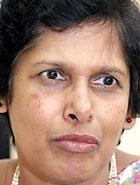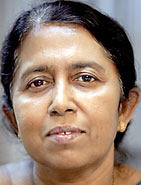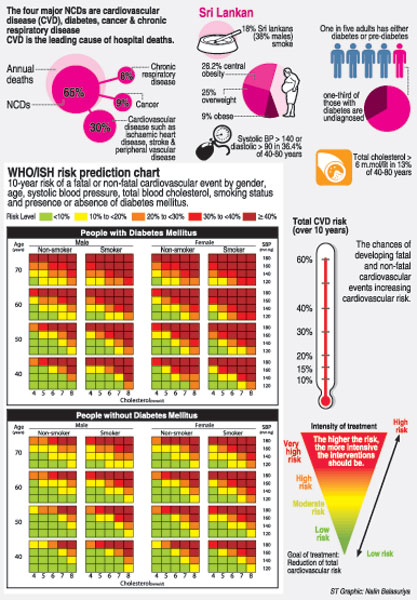News
Tackling heart disease the tried and tested way
View(s):Multiple risk factors to be treated with drugs, changed lifestyles for single risk cases
By Kumudni Hettiarachchi
A drastic but tried and tested change is being introduced in the management of risk factors that are harbingers of diseases of the heart or blood vessels. Not just a part, but the whole picture is being looked at to cut down disease and deaths from cardiovascular disease (CVD), while avoiding unnecessary medication of people, the Sunday Times understands.
 Dr. Padma Gunaratne |
 Dr. Thalatha Liyanage |
In the battle against CVD, the focus now is to screen people at community level and make an informed decision to treat with medications, having taken into consideration the presence of ‘multiple risk factors’ rather than treating those with ‘a single risk factor’, it is learnt.
This is the strategy that is being promoted by the World Health Organisation (WHO), after developed countries with solid data have tried and tested it, said Dr. Thalatha Liyanage, Director of the Health Ministry’s Non-Communicable Disease (NCD) Unit.
Stroke Specialist Dr. Padma Gunaratne explained that those with ‘mildly-raised multiple risk factors’ are at a higher risk of developing CVD than those with ‘a mildly-raised single risk factor’. While people with ‘a significantly-raised single risk factor’ (blood pressure more than 160/100 mm Hg or a total cholesterol more than 8 mmol/l) will be treated with drugs, others with ‘a mildly-raised single risk factor’ would be advised on lifestyle changes and monitored regularly. Diabetes treatment would be intensified as has been practised in the past.
The ‘Total Risk Appraisal’ of people at community level, with the WHO Guidelines for Assessment and Management of Cardiovascular Risk, modified by the Ceylon College of Physicians to suit Sri Lanka, are being scrupulously adhered to, points out Dr. Liyanage. The NCD Policy is to reduce “premature deaths” (of those below 65 years) due to CVD and the target is to cut such deaths by 2% annually over the next 10 years.
The four major NCDs are CVD, diabetes, cancer and chronic respiratory disease, with the modifiable or changeable risk factors being smoking, high blood pressure, high blood sugar and high cholesterol. The “underlying” issues leading to them are unhealthy diet, lack of physical activity and tobacco and alcohol use.
“There is a strong prevention model being implemented in the country which includes awareness programmes as well as 550 ‘healthy lifestyle centres’ in primary healthcare institutions in all districts,” says Dr. Liyanage, pointing out that grass-roots level health workers encourage people to get screened.
The screening would include checking blood pressure, blood sugar and cholesterol as well as evaluating the case history whether smoking or non-smoking, alcohol intake and family history of diseases such as diabetes, heart attacks and stroke, it is learnt.
Thereafter, doctors at primary healthcare level would calculate the risk of a person developing CVD that includes stroke and heart attacks, over the next 10 years using the WHO Risk Prediction Charts. The estimated CVD risk would be communicated to that person to make him/her avoid high risk behaviour, Dr. Liyanage said.
The new policy will catch the high risk group early, points out Dr. Gunaratne, adding that the primary healthcare doctors will categorize the risk level of a person as low, medium or high. Advice on lifestyle modification would follow. Prescribing of drugs would be based on treatment protocols provided to the primary healthcare doctors.
“What is of paramount importance is that two or more risk factors don’t just add up but get dangerously multiplied,” she said.
Anyone who has a 30% or over categorization would fall into the high risk level and medication begun for their management while those with 20-30% would be guided to change their lifestyles and monitored for four to six months prior to beginning drug treatment, says Dr. Gunaratne.
Citing an example, she says a person who has mild hypertension (blood pressure) with no other risk factors would not be prescribed any drug but encouraged to change the lifestyle as opposed to another who has three or more risk factors. By this method we will be avoiding more attacks as the intervention is applied at a higher baseline risk than the single risk factor approach.
The burden of CVD is enormous, she says, adding that it not only contributes to 1/3rd of deaths globally but is likely to remain in the three top causes even by 2030.
Looking at numbers, Dr. Gunaratne gives clear evidence of the benefit of the ‘total risk approach’ vs. ‘single risk approach.’ With 50% falling into the ‘single risk approach’ and only 12.4% into the ‘total risk approach’ (high risk approach), high-risk people could be intensively targeted to prevent cardiovascular episodes such as heart attacks and strokes; those with mild multiple risk factors treated and those with mildly raised one risk factor advised on lifestyle modifications (eating patterns, need for exercise, giving up smoking or alcohol) to control that single risk factor without taking drugs.
“Then we focus on the highest risk category and save them from disease and death, minimise the side-effects and unnecessary cost of drugs in the case of others and also avoid the need to upscale facilities. This is suitable for settings like ours with limited resources to save the greatest number of lives at the lowest cost,” says Dr. Gunaratne.
The funds thus saved can be utilized to take tertiary and specialized care for complications to a different level, adds Dr. Liyanage.
The simple message, according to Dr. Gunaratne, is that the intensity of interventions and treatment for the prevention of CVD among the people should look at the “whole picture”. To cut down the risks and disease and death that follow, what is needed is a mix of ‘a wider population strategy’ on lifestyle changes and ‘a high-risk strategy’ to catch those vulnerable into a treatment net.

Follow @timesonlinelk
comments powered by Disqus















